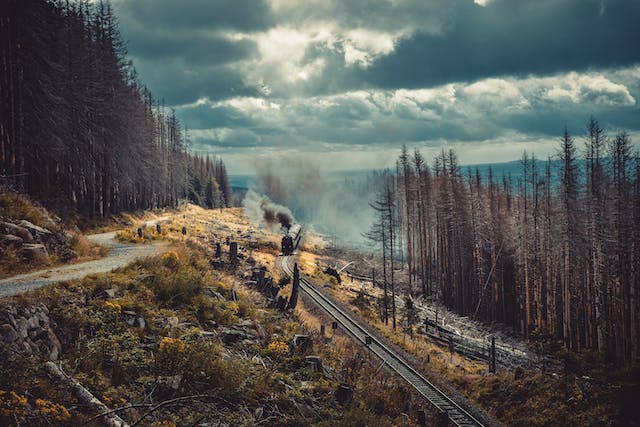
What is the steepest railway track a train can go up? The steepest track is the Calçada de São Francisco in Portugal, and it has an incline of 13.8%.
This question has several parts because there are different ways that trains connect to a track. The most common type of train attaches to the track through friction adhesion. Then there are maglev trains that don’t connect to the track but ride on a cushion of magnetism. Then there is a rack railway, where the train has a cog that fits into a rack on the tracks. And, finally, there are funicular trains that are pulled up by a cable.
Most trains have metal wheels that ride along a metal rail. You would think that a metal wheel would not be able to grip a metal rail, but, obviously, train wheels do grip. The main reason is because of the weight of the train. Train carriages are extremely heavy and there can be forces of ten tons or more pushing each wheel down onto the rail. That is enough pressure to create friction between the wheel and the rail, and it is called adhesion. However, it doesn’t create as much friction as the wheels of a car, which is why trains are far more economical than cars or trucks. Less friction means they lose less energy to heat. Adhesion holds the wheels to the rail, but they can slip. Trains have to accelerate and slow down very slowly because of the low friction between the wheels and the rails. Old trains used to put sand on the rails so that they could get enough grip to start. These days, electric motors at different points on the train and computers spread out the acceleration to makes sure the wheels don’t slip.
A train on an adhesion railway grips well, but as the railway gets steeper, it will start to lose grip and there will be a point where it cannot move forward. The steepest adhesion railway is 13.8%, which is 1 in 7.2. That means for every 7.2 m the railway goes forward, it goes up by 1 m. This is a very rare situation and is only possible because a small tram is riding the rail. Trams have more power to each individual wheel, giving them more acceleration and grip. Most trams don’t go over 10% and most passenger commuter trains don’t go over 4%. High speed railways don’t go over 2.5% and freight trains don’t go over 1.5%. The steeper the incline, the slower the train has to go and the more power it needs. This also means that freight trains have to be lighter. 1.5% is the maximum gradient that lets them climb it while fully loaded.
Maglev trains are not limited by friction in the same way. They use magnetic propulsion and don’t touch the ground. A maglev train can go up a 4% incline without losing any speed. The SuperConducting Maglev train in Japan can travel at 500 km/h on a 4% incline. However, as the incline gets greater, the train will start to lose speed due to gravity. The same SC Maglev can only reach 322 km/h on a 10% incline. A maglev train could theoretically go vertically, but there would have to be enough power to overcome the force of gravity and the train would have to be very light.
The steepest rack railway is the Pilatus Railway in Switzerland. It reaches a gradient of 48% in places. A rack railway has a cog connected to the wheels of the train engine and a rack in the center of the railway, between the two rails. The power of the engine turns the cog and it grips the rack, giving the train traction when there wouldn’t be enough power or friction to keep the wheels gripped the metal rails. Rack railways can take trains up much steeper gradients than regular trains.
Then there are funicular railways, which is a train that is pulled up a slope by a cable. Usually there are two cars, both fastened to opposite ends of the same cable, and one goes up while the other goes down. The train has wheels so it can ride on the track, but it doesn’t use them for grip or power. All the power comes from the cable. Because they are just being pulled, funicular railway trains can go up gradients that no other type of train would be able to consider. The steepest funicular train is the Stoosbahn in Switzerland that has a gradient of 110%. That means, for every 100 m the track goes forward, it goes up 110 m. And that is what I learned today.
Photo by Mark Plötz: https://www.pexels.com/photo/green-trees-under-white-sky-2790395/
Sources
https://www.dispatch.com/story/lifestyle/2016/09/30/did-you-know-if-trains/24106711007/
https://en.wikipedia.org/wiki/List_of_steepest_gradients_on_adhesion_railways
https://en.wikipedia.org/wiki/Adhesion_railway
https://en.wikipedia.org/wiki/Funicular
https://en.wikipedia.org/wiki/Rack_railway
https://www.smh.com.au/traveller/inspiration/traveller-10-rack-railways-20181219-h199vx.html
https://lovethemaldives.com/faq/can-freight-trains-go-uphill
https://scmaglev.jr-central-global.com/
